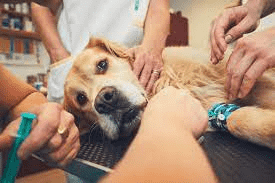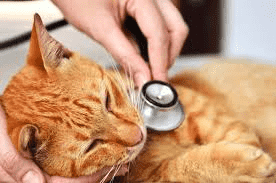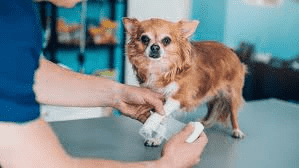What is Pet Insurance?
Pet insurance helps cover the cost of medical expenses should your pet become ill or have an accident. A few plans also cover wellness visits and routine veterinary expenses such as vaccinations, spaying/neutering, heartworm testing/medications, etc. for an additional fee.
Why Should You Consider Using Pet Insurance?

Pet insurance can be most helpful for the unexpected – catastrophic medical events that are costly and hard to predict therefore budget for.
Routine and wellness procedures are not always best handled with pet insurance. Sometimes the annual cost of adding routine and wellness care to your plan ends up being more than it would cost you if you paid for these procedures out of your own pocket, so make sure you do the math before you enter into a plan like this.
It is possible that you will pay more in premiums than you get back if your pet stays relatively healthy, therefore pet insurance (like any other insurance) should be used as a risk management tool, not as a way to save money.

How does Pet Insurance Work?
Pet insurance is similar to human health insurance in that it:
- Has premiums, deductibles, co-pays and maximum payouts.
- Some plans have waiting periods that define when coverage starts. Many companies exclude pre-existing medical conditions.
Pet insurance differs from human health insurance in that:
- Most plans DO NOT does not cover pre-existing conditions.
- It is a reimbursement based: This means you pay the vet bill, and then you file the claim with the pet insurance company for reimbursement. It is very different from human medical insurance where the doctor files the claim and receives the payment directly from the insurance company. This means you will have to have some means to pay the veterinary bill while you wait for reimbursement.
- Pet insurance companies do not use networks. You are able to visit any licensed veterinarian in the U.S. Some plans also allow you to visit a licensed veterinarian in another country while traveling.

How to Select a Pet Insurance Plan
Selecting a pet insurance plan is an individual choice because each person and pet has different needs depending on the animal’s breed, owner’s geographical location and budget.
First, determine if you need pet insurance. If you can cover the worst case scenario costs for your geographic location out of your own pocket, then you may not need pet insurance. Please keep in mind that many emergencies can cost between $3000-$7000. In some cases, emergencies can go over these amounts.
If you determine that you need pet insurance, make sure the pet insurance company you choose has the following attributes:
- Has good medical coverage – To get the most comprehensive coverage, you want to purchase a plan that covers accidents/injuries AND illnesses. The illness part of the coverage must include (these are common ailments in veterinary medicine):
a) Coverage for cancer
b) Coverage for chronic disease – Chronic diseases are illnesses that have long duration and generally slow progression. Examples include cancer, heart disease, diabetes, and feline immunodeficiency virus.
c) Continual coverage for chronic disease – This is very important. If you do not get this coverage, the chronic disease will only be covered in the policy year it was diagnosed, and after that you will have to pay for any continuing medications or diagnostic monitoring yourself. To further this point, you will pay the same monthly premium even though you have lost coverage for the disease. - Treatment for most chronic diseases will last beyond the first year of diagnosis, therefore it is important to have coverage in this area. This includes things like allergies, diabetes, Cushing’s disease, kidney disease, hyperthyroidism, osteoarthritis, inflammatory bowl disease and as mentioned before heart disease and cancer.
- Company has a good reputation.
- Research a pet insurance company’s reputation using the Better Business Bureau and your state’s department of insurance. You can also ask your veterinarian what their clients’ experiences have been
- Has a strong underwriter.
The underwriter is the company that is financially responsible for paying your claim. Use AM Best to research the strength of the underwriter. - Has a maximum payout limit that will cover the worst case scenario costs for your geographic location. The maximum payout limit is the maximum amount of money the insurance company will reimburse you. This payout limit can be annual, lifetime, per incident, per body system, or based on a predetermined benefit schedule. You want to pick a maximum payout structure that will cover the worst case scenario costs.
- Has an affordable premium.
- Pays claims in a timely fashion.
- Does not have unreasonable exclusions and requirements.
– Exclusions are medical conditions that are not covered by the plan.
– Requirements are things you must do to remain insured (e.g. annual exams, animal must reside in the place of residence listed on the policy, submission of medical records, and adherence to the vaccination recommendations).
– Exclusions and requirements are written in the pet insurance company’s terms and conditions. It is important that you read this document before and after you buy so that there are no surprises.
What about Accident Only Policies?
As the name implies, accident only policies cover accidents only. They do not cover medical costs caused by illnesses.
Accident only policies tend to be much cheaper than comprehensive accident and illness policies because they do not cover costly illnesses.
Also, as a pet ages, the number of accident-related injuries decreases in comparison to the number of illness-related conditions.
In addition, what a pet owner considers to be an accident is not necessarily what a pet insurance company considers to be one. For example, some companies will not cover conditions such as foreign body ingestion or cruciate injuries in their accident only policies.
If you intend to buy an accident only policy, make sure you know what you are getting for your money.
Key Points Regarding Pet Insurance
- Never buy pet insurance without doing your own research.
- Do not pick pet insurance solely based on the cost of the premium. Make sure you consider the monetary and medical coverage it provides.
- Read the terms and conditions of the pet insurance plan. Make sure you understand all the exclusions and requirements in the policy.
- Ask the company for a list of exclusions based on your pet’s past medical history and breed.
Usually you have to purchase the policy first to receive this type of review and you will have to submit medical records. Also, not all pet insurance companies offer this option, but if they do it will give you a list of the exclusions you can expect based on your pet’s prior history. If you don’t like what is on this list, you can cancel the policy within the money back guarantee period. - Do not wait until your pet has an illness or injury before you buy pet insurance as it will be considered a pre-existing condition and will not be covered by your policy.
- Know which states are covered by the plan.
- Not all pet insurance companies are licensed to sell insurance in all states. Therefore, before buying a pet insurance plan make sure the company sells plans in your state and any state you may be thinking of moving to. Also, make sure the coverage will be the same in the new state.
- If you have to switch pet insurance companies, any medical conditions your pet had under the old company may be considered pre-existing by the new company.
- Know the enrollment age range of the plan.
This is the age your pet must be to sign up for a new policy. There is usually a low end and a high end. There can be one range for dogs and one range for cats. There can also be ranges for certain breeds. - Make sure you ask the company how and when your premium can increase.
- Make sure you understand what the company’s waiting periods are as it will vary from company to company.
- Make sure you understand the company’s pre-existing conditions policy as it will vary from company to company.
- Make sure you understand the company’s bilateral conditions policy.
- A bilateral condition is any condition that can happen on both sides of the body. Some companies have restrictions on how much they will cover for these types of conditions. Examples of bilateral conditions include, but are not limited to, hip dysplasia (could happen in both hips) and cruciate injuries (could happen in both knees).
- Pet insurance companies are businesses.
– As businesses, one of their top priorities is to make a profit. They can and may change your rates and terms to meet that top priority. A change of business ownership or underwriters can also be a catalyst for changes in your rates and terms.
When you purchase pet insurance, make sure you have a realistic understanding of this and how it can affect you.


